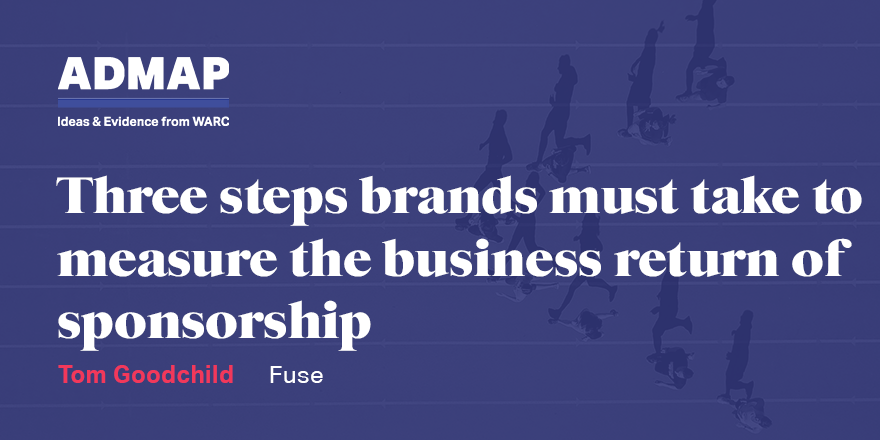Sponsorship is a vital channel for marketers, but for too long measurement has remained a mystery. This month's edition of Admap explains how brands can achieve sponsorship effectiveness.
Change is coming to sports sponsorship marketing – and not before time. For too long, sponsorship has been based on the whims of execs who happen to harbour a lifelong passion for baseball, soccer or cricket. Even worse, the success of that investment has been evaluated largely with blunt outputs such as social likes and media exposure, rather than any measurement of business impact.
Admittedly there are some mitigating circumstances: sponsorship activation will typically run across online and offline channels, and is often managed in disparate siloes across an organisation. Indeed, a recent survey by Kantar found sponsorship to be the least-understood channel from an ROI perspective, with 44% unable to pinpoint its short- or long-term impact on brand performance.
Despite these challenges, the sponsorship market is going from strength to strength. WARC Data predicts that spend on sports sponsorship will rise 5% in 2020 to reach $48.4bn worldwide – the strongest growth in a decade, driven in part by this summer’s Tokyo 2020 Olympic Games.
In this month’s edition of Admap, we share best practice advice on how to design a sponsorship framework for effectiveness. The report offers guidance on how to select the right sponsorship property, and how to measure success. We also shine a light on key sponsorship trends such as the rise of women’s sport and the advent of the digital athlete.
Highlights include:
In Three steps brands must take to measure the business return of sponsorship, Fuse’s director of effectiveness Tom Goodchild argues it is possible to integrate sponsorship measurement into existing approaches, and allow direct comparison with other marketing channels.
Ajay Jilka, business director at Culture Group, offers an in-depth analysis of a expanding sponsorship landscape in Kicking goals and the rise of the digital athlete: A new decade in China’s sports marketing. From the impact of the Beijing 2008 Olympics to the rapid growth of e-sports, Jilka outlines opportunities for brands in China’s sponsorship market.
Sponsorship is one of the few touchpoints that allows advertisers to target very specific, often hard-to-reach target groups. Kantar Media senior director Maren Seitz outlines four vital success factors for sponsorship effectiveness in How to score a home run with sponsorship.
Jim Andrews, an independent sponsorship consultant, summarises key trends in the North American sponsorship market in Sponsorship in transition: The outlook for 2020. According to Andrews, many direct-to-consumer companies – as well as those in the legal cannabis category – are reaching the scale required to compete with established brands for prized sponsorship properties.
It can be hard for brands to stand out when sponsoring those tier-one properties. In Finding and activating the ‘sweet spot’ on the sponsorship platform – and citing examples including Procter & Gamble’s ongoing ‘Mom’ Olympic campaign – Professor Tony Meenaghan and Core Sponsorship’s Jill Downey and Jamie Macken argue that, with the right insight-driven approach, it is still possible for sponsors to cut through the clutter.
Women’s sport is enjoying a rapid growth in popularity with audiences, most visible in the success of last year’s FIFA Women’s World Cup. However, according to MediaCom’s Misha Sher in Women’s sport: From niche to mainstream, brands seen to be jumping on a bandwagon or lacking commitment will receive a harsh response from audiences.
Few sponsorship opportunities can match the scale of the Olympic Games. In Tokyo 2020 Olympics: What US brands need to know, Jeremy Carey, managing director at Optimum Sports, reveals that Olympic sponsors should aspire to “staying power” by extending the impact of campaigns beyond the two-week competition window.
As the cost of activation increases, brands should apply a creative lens to sponsorship programmes, claims Neil Hopkins, global head of strategy at M&C Saatchi Sport & Entertainment. In Creativity and long-term brand-building through sponsorship, Hopkins explains that an effective sponsorship marries consumer, brand and passion insights to deliver a compelling proposition.
Few trends in sponsorship are as significant as the rise of e-sports. In Developing an e-sports sponsorship framework in Asia, Octagon’s Jian Ming Lee offers a five-step guide for brands exploring the potential of e-sports, with advice on which game to sponsor and how they should measure their investment.
In his article, Alex Burmaster, co-founder of caytoo, sets out How to make the most of your sponsorship. A really good sponsorship will integrate a brand’s product or service into the fabric or experience of the event, Burmaster writes.
For brands with smaller budgets, South East Asia’s football market offers many opportunities, according to Marcus Luer, founder and group CEO Total Sports Asia. In Why football can help brands to connect with consumers in South East Asia, Luer explains that soccer sponsorship can be a vital channel through which to reach rural and small-town communities across ASEAN.
Finally, while TV remains the primary device for coming live sports coverage, in Sports partnerships and the continuing power of live, Sky Media’s David Shore describes how brands can activate coverage through a multitude of new video, audio and experiential content formats.
In addition to the articles, WARC subscribers can also access a deck summarising the expertise and insights from all our contributors.


